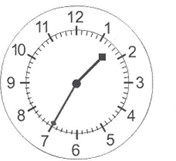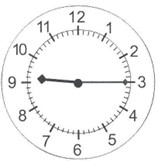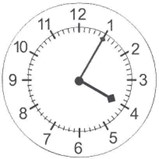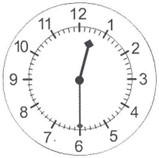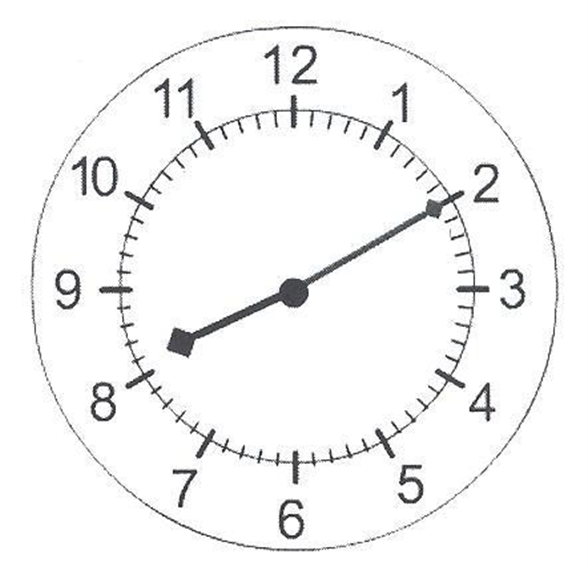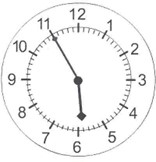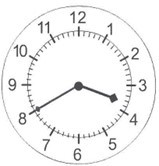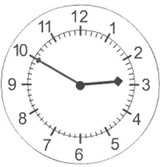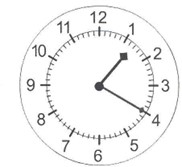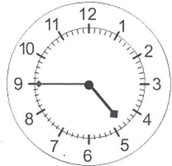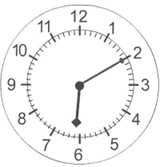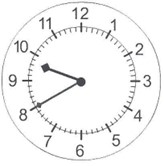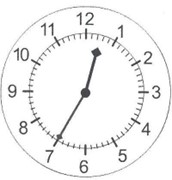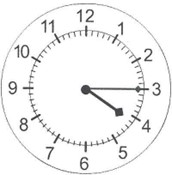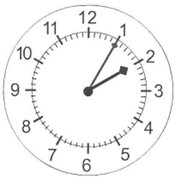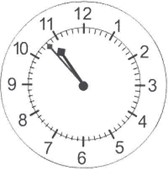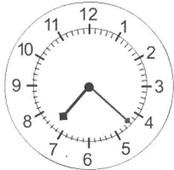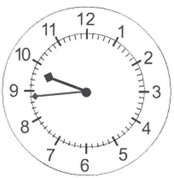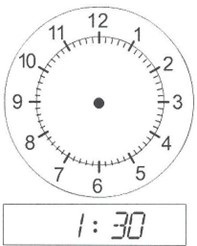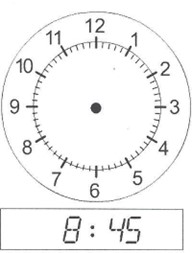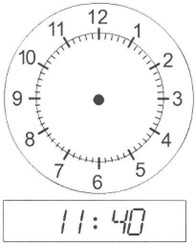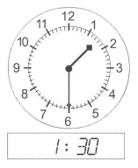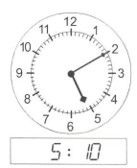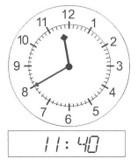Unit 5: Making Change, Time & Perimeter
Topic C: Telling Time
We have always been interested in keeping track of time. Sundials were the first way used to keep of track of time. The sundial had limits. It needed the sun and could not keep track of time at night. Through the centuries, many things have been used to keep track of time. In our modern society, we have used clocks. There are two types of clocks; digital and analog. Digital clocks display the time as numbers.
Analog clocks are clocks with hands. The shorter hand tells the hour and the longer hand tells the minutes. An easy way to remember the hour hand and the minutes hand is that hour is a shorter word than minute, and the shorter hand tells the hour.
In an analog clock, the minute hand travels faster than the hour hand as it has to cover 60 minutes. The hour hand only needs to travel between the numerals in the same time it takes the minute hand to cover 60 minutes.
To tell what time it is, look at the shorter hand to figure out what hour it is. Next, look at the minute hand to figure out the minutes. Each numeral of the clock represents a certain number of minutes. Look at the chart.
| Numeral | Minutes |
|---|---|
| 1 | 5 |
| 2 | 10 |
| 3 | 15 |
| 4 | 20 |
| 5 | 25 |
| 6 | 30 |
| 7 | 35 |
| 8 | 40 |
| 9 | 45 |
| 10 | 50 |
| 11 | 55 |
| 12 | o’clock |
Exercise One
Write the time shown on each clock. Check your work using the answer key at the end of the exercise.
Example A:
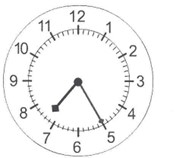
The shorter hand is closer to the 7. The longer hand is before the six. This means that the hour is 7. The longer hand is pointing to the 5. This means 25 minutes (check the chart on the page before). The time would be written as 7:25.
Example B:

Look at the shorter hand. If the longer hand is past the six, then the hour is the numeral before the one the shorter hand is pointing at. This means that the hour is 12. The longer hand is pointing at the 10. This means 50 minutes (check the chart on the page before). The time would be written as 12:50.
Answers to Exercise One
- 1:35
- 9:15
- 4:05
- 12:30
- 8:10
- 5:55
- 3:40
- 2:50
- 1:20
- 4:45
- 12:25
- 6:10
- 8:50
- 9:40
Exercise Two
Under each clock is a time on a digital clock. Put the hands on the analog clock to show the digital time. Check your work using the answer key at the end of the exercise.
Answers to Exercise Two
24-hour Clock
Your friend said she would meet you at 8:00 o’clock. Does that mean in the morning or the evening? We use a.m. and p.m. to know whether it is morning or evening.
Another way to avoid confusion is by using the 24-hour clock. Airlines, military and health care are examples of places where the 24-hour clock is used.
With the 12-hour clock, each of the hours is repeated is a day. In the 24-hour clock, each hour in a day is counted giving us 24 hours. In the 24-hour clock, 12:00 a.m. can be written as 0000 or 2400. 0000 is the start of a new day, while 2400 is the end of the day.
We write times with 4 digits. The first two digits are the hours and the next two digits are the minutes.
| 12-hour clock | 24-hour clock | 12-hour clock | 24-hour clock |
|---|---|---|---|
| 12:00 a.m. | 0000 or 2400 | 12:00 p.m. | 1200 |
| 1:00 a.m. | 0100 | 1:00 p.m. | 1300 |
| 2:00 a.m. | 0200 | 2:00 p.m. | 1400 |
| 3:00 a.m. | 0300 | 3:00 p.m. | 1500 |
| 4:00 a.m. | 0400 | 4:00 p.m. | 1600 |
| 5:00 a.m. | 0500 | 5:00 p.m. | 1700 |
| 6:00 a.m. | 0600 | 6:00 p.m. | 1800 |
| 7:00 a.m. | 0700 | 7:00 p.m. | 1900 |
| 8:00 a.m. | 0800 | 8:00 p.m. | 2000 |
| 9:00 a.m. | 0900 | 9:00 p.m. | 2100 |
| 10:00 a.m. | 1000 | 10:00 p.m. | 2200 |
| 11:00 a.m. | 1100 | 11:00 p.m. | 2300 |
For example, 8:20 a.m. would be 0820, while 8:20 p.m. would be 2020.
To convert 12-hour clock to 24-hour clock, add 12 to the hour for any times after 1:00 p.m. to 11:59 p.m.
Example: 6:30 p.m.
6:30 + 12:00 = 1830
Example: 10:30 p.m.
10:30 + 12:00 = 2230
When writing times in 24-hour clock, we do not use a colon.
Exercise Three
Change each 12-hour clock time to 24-hour clock time. Watch carefully for a.m. and p.m. Remember: only times between 12:00 p.m. and 11:59 p.m. need to be changed. Check your work using the answer key at the end of the exercise.
- 6:30 a.m.
- 10:45 p.m.
- 8:10 p.m.
- 4:15 a.m.
- 7:35 p.m.
- 9:40 a.m.
- 5:30 a.m.
- 11:50 p.m.
- 1:55 p.m.
- 2:05 a.m.
- 3:20 p.m.
- 12:25 a.m.
Answers to Exercise Three
- 0630
- 2245
- 2010
- 0415
- 1935
- 0940
- 0530
- 2350
- 1355
- 0205
- 1520
- 0025
Exercise Four
Change each 24-hour clock time to 12-hour clock time. Watch carefully for a.m. and p.m. Check your work using the answer key at the end of the exercise.
- 1204
- 0822
- 1842
- 0425
- 1440
- 0910
- 1735
- 1605
- 0342
- 2305
- 0550
- 1330
Answers to Exercise Four
- 12:04 p.m.
- 8:22 a.m.
- 6:42 p.m.
- 4:25 a.m.
- 2:40 p.m.
- 9:10 a.m.
- 5:35 p.m.
- 4:05 p.m.
- 3:42 a.m.
- 11:05 p.m.
- 5:50 a.m.
- 1:30 p.m.
Exercise Five
Below are the ferry schedules from West Vancouver (Horseshoe Bay) to Nanaimo (Departure Bay) and Vancouver (Tsawwassen) to Nanaimo (Duke Point).. Change each 12- hour clock time to 24-hour clock time. Check your work using the answer key at the end of the exercise.
| Leave West Vancouver (Horseshoe Bay), Departs | 24-hour clock time | Leave Vancouver (Tsawwassen), Departs | 24-hour clock time |
|---|---|---|---|
| 6:30 a.m. | 5:15 a.m. | ||
| 8:30 a.m. | 7:45 a.m. | ||
| 10:30 a.m. | 10:15 a.m. | ||
| 12:30 p.m. | 12:45 p.m. | ||
| 3:00 p.m. | 3:15 p.m. | ||
| 5:00 p.m. | 5:45 p.m. | ||
| 7:00 p.m. | 8:15 p.m. | ||
| 9:00 p.m. | 10:45 p.m. |
Answers to Exercise Six
| Leave West Vancouver (Horseshoe Bay), Departs | 24-hour clock time | Leave Vancouver (Tsawwassen), Departs | 24-hour clock time |
|---|---|---|---|
| 6:30 a.m. | 0630 | 5:15 a.m. | 0515 |
| 8:30 a.m. | 0830 | 7:45 a.m. | 0745 |
| 10:30 a.m. | 1030 | 10:15 a.m. | 1015 |
| 12:30 p.m. | 1230 | 12:45 p.m. | 1245 |
| 3:00 p.m. | 1500 | 3:15 p.m. | 1515 |
| 5:00 p.m. | 1700 | 5:45 p.m. | 1745 |
| 7:00 p.m. | 1900 | 8:15 p.m. | 2015 |
| 9:00 p.m. | 2100 | 10:45 p.m. | 2245 |
Topic C: Self-Test
Mark /22 Aim 17/22
- Write the time shown on each clock. (6 marks)
- Under each clock is a time on a digital clock. Put the hands on the analog clock to show the digital time. (4 marks)
- Change each 12-hour clock time to 24-hour clock time. Watch carefully for a.m. and p.m. (6 marks)
- 6:25 a.m.
- 11:05 p.m.
- 2:55 p.m.
- 10:40 a.m.
- 4:00 p.m.
- 8:15 a.m.
- Change each 24-hour clock time to 12-hour clock time. Watch carefully for a.m. and p.m. (6 marks)
- 0155
- 0020
- 1935
- 0545
- 1530
- 2110
Answers to Topic C Self-Test
-
- 12:35
- 4:15
- 2:05
- 10:53
- 7:22
- 9:44
-
-
- 0625
- 2305
- 1455
- 1040
- 1600
- 0815
-
- 1:55 a.m.
- 12:20 a.m.
- 7:35 p.m.
- 5:45 a.m.
- 3:30 p.m.
- 9:10 p.m.

